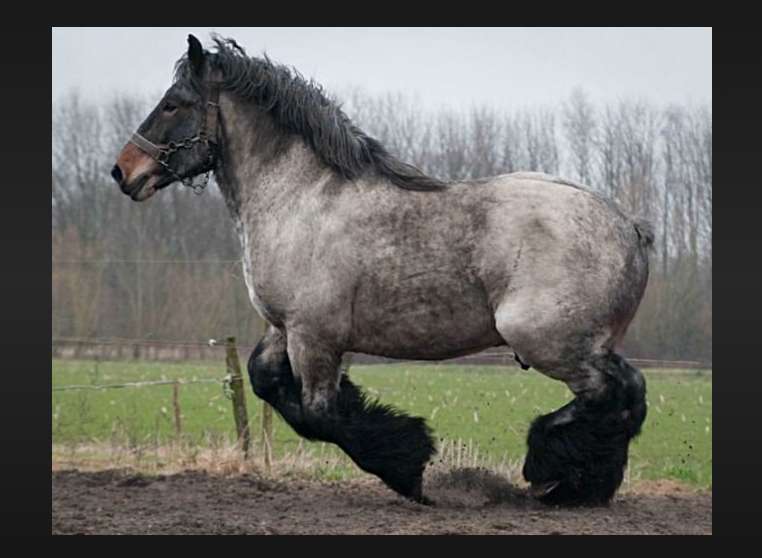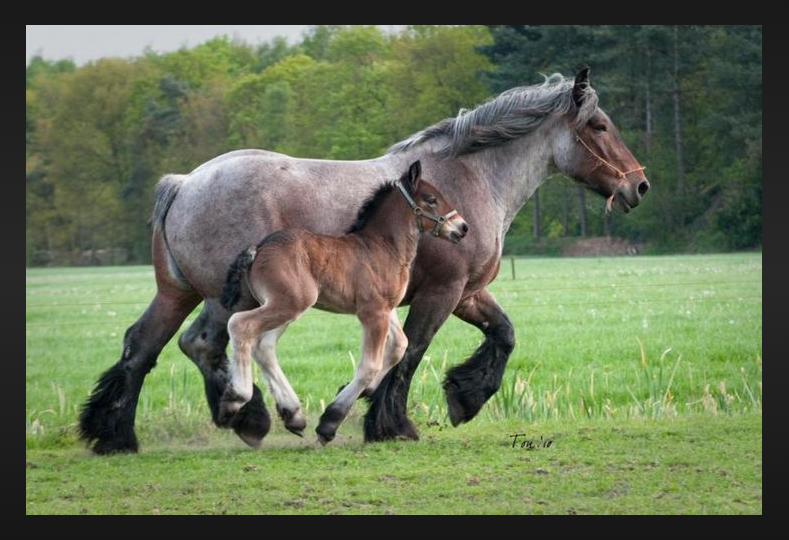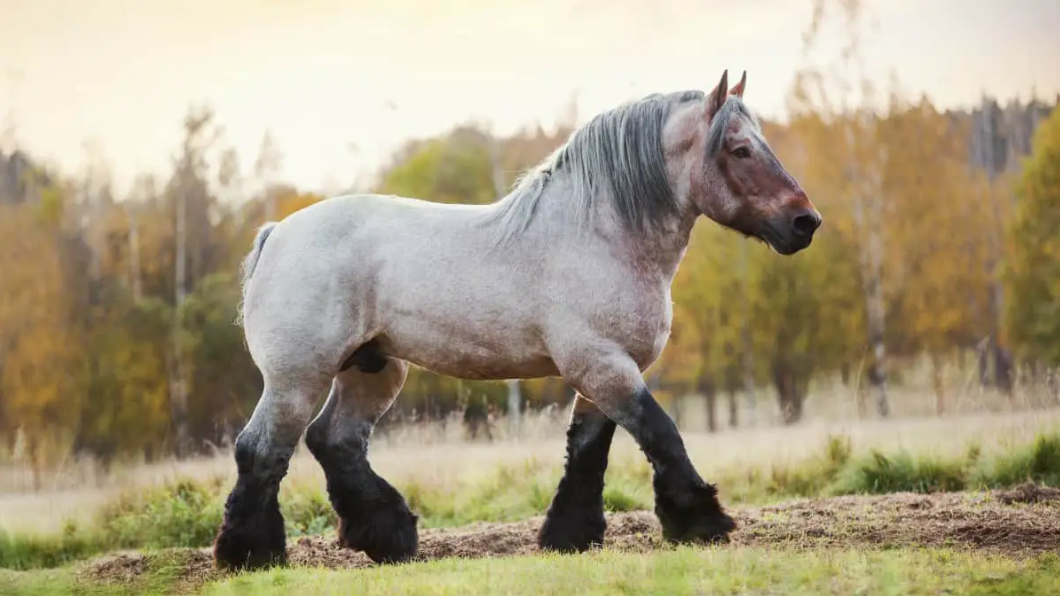Belgian Draught Horse
It is the Belgian Draught Horse is also called”the Belgian Draft Horse as well as the Belgian horse is a breed of draft horse which originated in Belgium. It is among the most powerful and heavy horses, well-known for its strength and gentle disposition.
Here are some important features and details on this horse: Belgian Draught Horse:
Physical Specifications:
- size: Belgian horses are massive and heavy, with an athletic structure.
- Colour: A common color for coats is chestnut or sorrel which has flaxen hair and tail. There is also white blazes on their face, and white marks around their legs.
- Feathering Belgians have a reputation for their long, silky feathering (long hair) on their lower legs, and especially on the fetlocks.
The Power and Strength:
- Belgians are known as strong and have pulling strength. They are typically used for draft work heavy in farms as well as pulling ploughs, and other machinery.
Temperament:
- Belgian Draught Horses are known for their gentle and calm nature. They tend to be friendly and eager to learn, and easy to train which makes them appropriate for a variety of jobs.
History:
- It is believed that the Belgian horse is a breed with a long-standing history that dates back to the medieval era. The breed was bred by the Brabant region in Belgium and was selectively bred to increase durability and endurance through the ages.
Uses:
- In the past, Belgian horses were primarily used for plowing fields and for other heavy farm tasks.
- Nowadays they’re still employed for agriculture, but are also used in a variety of other tasks, including the logging industry, carriage driving and even as show horses.
Popularity:
- Belgians are popular not just in Belgium but also across the world. They are frequently seen at fairs and contests for agriculture.
Conservation Status
- The Belgian Draught Horse is not considered to be endangered or threatened breed. The popularity of the breed has led to its wide distribution across the globe.
Associations:
- Numerous breed clubs, within Belgium as well as internationally, strive to preserve and promote the standard that are set by breeds like the Belgian Draught Horse.
Belgian Draught Horse Health and Feeding
Health:
Regularly scheduled veterinary check-ups:
- Regularly check-ups with a vet to check general health and well-being of your horse. This includes dental check-ups along with vaccinations and parasite prevention.
Hoof Care
- A regular hoof cleaning is vital. Make sure that your hooves are kept clean and well-maintained to avoid issues like lameness.
Exercise:
- Although Belgians are sturdy and strong exercising regularly is vital for their overall health. Offer opportunities for turnout and exercising to ensure the joint’s health and muscle tone.
Temperature Management
- Belgian Draught Horses may have an extremely thick coat, therefore be aware of extreme weather conditions. Make sure they have shade and access to water during the heat and assure that they are provided with adequate shelter in winter.
Deworming:
- Make sure you follow a schedule of deworming as recommended by your physician to manage internal parasites.
Dental Care:
- Regular dental exams are vital to assure proper digestion and chewing. Dental problems can hinder the ability of a horse to eat and cause weight loss.

Feeding:
Forage:
- Make sure you have a high-quality forage, such as bollshay, or even pasture. Belgians have a large appetite and forage is crucial to assure good digestion.
The Grain and Concentrates
- Based on the horse’s work load and age as well as health, it is possible to add concentrates or grains. Discuss with your vet to determine the proper amounts and kinds of feed.
Protein:
- Make sure your horse’s food contains sufficient protein to benefit develop muscles. Legumes and hay of good quality are excellent sources of protein.
Vitamins, minerals and Vitamins:
- The diet should be balanced with vital vitamins and minerals. This is especially important to ensure solid bones as well as overall well-being. If needed, favor mineral supplements.
Water:
- Provide clean water that is fresh and clean throughout the day. Horses are known to consume a large quantity of fluids, particularly when fed forages that are dry.
Feed Frequency:
- Set up a regular feeding schedule. They are habit-forming creatures and having a consistent feeding schedule will benefit keep their digestive health in check.
The Monitor’s Weight
- Continuously check the horse’s weight. Modify the feeding schedule in order to avoid overweight or deficiency in nutrition.
Particular Considerations
- The foals of pregnant mares, the growing ones and working horses could require specific diets. Speak with a veterinarian horse nutritionist for specific diet programs.
Belgian Draught Grooming and Horse Care
Care:
Shelter:
- Make sure you have adequate shelter in order to protect your Belgian Draught horse from the extreme weather conditions such as cold, heat, rain, and even wind.
Clean Environment:
- Maintain the living space of your horse tidy to minimize the chance of contracting diseases and bring the horse with a comfortable place for relaxation.
The Hoof:
- Check and clean regularly the hooves regularly to eliminate dirt and to prevent problems like thrush. Plan regular farrier visits to ensure trimming the hoof and for maintenance.
Exercise:
- It is important to assure that the horse receives regular exercise to ensure physical and mental health. The freedom of movement and turning out are good for horses.
Dental Care:
- Regular dental visits are recommended to fix any dental problems and to assure that your chewing is functioning properly.
The Vaccinations and Deworming Program:
- Make sure you follow a vaccination schedule advised by a doctor to safeguard against common ailments. Implement a deworming program to control internal parasites.
Emergency Preparedness:
- Plan for emergency situations which includes the ability to access veterinary services and first aid kits to treat minor injuries.

Grooming:
Brushing:
- It is important to regularly brush your horse’s coat to remove dust, dirt as well as loose hair. Make use of a body brush, curry comb, as well as a the tail and mane comb to ensure thorough grooming.
The Mane Care and the Tail
- Brush and untangle the tail and mane frequently to avoid mats and knots. You may want to consider together products for detangling to make grooming simpler.
Bathing:
- Make sure to bathe your horse every day particularly prior to shows or occasions. Apply mild horse shampoo and thoroughly rinse off any soap.
Feathering Care
- Pay particular attention to the feathering of your lower leg. Make sure it is clear of mud and dirt. Check regularly for symptoms of skin conditions or infections.
Cleansing the Eye and Ear
- Clean the horse’s ears as well as eyes frequently to get rid of dirt and other debris. Avoid causing any discomfort.
Teeth Examination:
- While it’s not a replacement for skillful dental treatment, it is a good idea to periodically examine the horse’s teeth to determine any obvious signs of problems or irregularities.
Tail Wrapping (Optional):
- Some owners prefer wrapping the tail to keep it from becoming filthy or damaged. If so, assure it is done in a way that isn’t causing discomfort.
Look for Bumps, Lumps and cuts:
- During grooming sessions, examine the body of your horse for bumps, lumps, cuts or indications of skin problems. Address any problems immediately.
Horse Clothing:
- In accordance with the climate, you may want to consider with sheets or blankets to shield the horse from harsh weather conditions.
FAQs
What is an Belgian Draught Horse?
- An Belgian Draught Horse is a breed of draft horse that originates from Belgium. They are renowned for their ability to withstand the elements and their gentle nature They have traditionally been employed for farming and other duties.
What is the features of the characteristics of Belgian Draught Horse?
- Belgian Draught Horses are large heavy horses with strong physique. They are typically adorned with chestnut or sorrel coats with a flaxen comb and tail. They are renowned for their feathers on the lower legs.
What’s the story of Belgian Draught Horse?
- This breed is known for its long and rich history that dates back to the medieval era. It was created within the Brabant region in Belgium and was then carefully bred for durability and endurance.
What is HTML0? Belgian Draught Horses used for in the present?
- While they were primarily employed in agricultural activities, Belgian Draught Horses are currently employed in a variety of things, like the logging industry, carriage driving and even as show horses.
How do I determine the nature of Belgian Draught Horses?
- Belgian Draught Horses are known for their gentle and calm nature. They tend to be friendly and eager to learn, and easily trained.
What is the perfect way to take care of the Belgian Draught Horse?
- Regular veterinary checks as well as regular exercise, proper nutrition as well as hoof care and care for grooming. A clean and safe environment are also important.
What kind of food should you feed an Belgian Draught Horse?
- The diet of the average person is high-quality forage, such as hay or sage that is supplemented with grains or concentrates if necessary. Minerals, proteins and vitamins should be balanced and having access to clean water is essential.
Do you know how to groom the Belgian Draught Horse?
- Regular grooming includes cleaning the coat and detangling the tail and mane while bathing as required as well as cleaning eyes and ears and examining hooves. The grooming of the lower legs needs particular care.
Do Belgian Draught Horses good for novices?
- Absolutely, Belgian Draught Horses are typically recommended for beginners because of their soft nature. However the proper training and supervision remain essential.
Are Belgian Draught Horses have specific health concerns?
- While they’re generally strong but they could be susceptible to health problems such as obesity. Regular check-ups with a veterinarian, dental health care, and a checking weight levels are essential.
How long will Belgian Draught Horses live?
- If they are properly treated, Belgian Draught Horses can remain healthy into their teens or early twenties, and occasionally even longer.
Do Belgian Draught Horses be used to ride?
- Although they are used primarily for driving and heavy duty work there are some people who are trained to ride. Their dimensions and built makes them ideal to harness and draft work.






